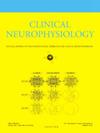腿部肌肉对肌间一致性作为肌萎缩性侧索硬化症的生物标志物
IF 3.6
3区 医学
Q1 CLINICAL NEUROLOGY
引用次数: 0
摘要
目的评价肌间相干性(IMC)作为肌萎缩性侧索硬化症(ALS)早期生物标志物的诊断潜力。方法对神经正常受试者和早期ALS患者的腓肠肌外侧-腓肠肌内侧肌(GLGM)、胫前-指短伸肌(TAED)和股外侧-股内侧肌(VLVM)进行表面肌电图(sEMG)记录。计算了20 ~ 40 Hz范围内的IMC (IMCβγ)和20 ~ 40 Hz范围内的虚相干分量(ICOHβγ)。采用受试者工作特征曲线下面积(AUC)评价诊断效果。结果肌萎缩侧索硬化症患者的simc βγ均低于神经正常组(p < 0.05)。诊断性能(AUC)范围为0.69 ~ 0.78,TAED最高。降低ICOHβγ对体积传导的影响倾向于提高诊断能力(AUC范围为0.76 ~ 0.84)。结论腿部肌肉(尤其是TAED)的simc βγ有助于早期ALS患者与神经正常个体的区分。ICOHβγ通过减少体积传导伪影进一步提高诊断性能。下肢肌肉IMC测量有助于ALS的早期准确诊断。本文章由计算机程序翻译,如有差异,请以英文原文为准。
Intermuscular coherence from muscle pairs in the leg as a biomarker for amyotrophic lateral sclerosis
Objective
To evaluate the diagnostic potential of intermuscular coherence (IMC) measured from leg muscle pairs as an early-stage biomarker for amyotrophic lateral sclerosis (ALS).
Methods
Surface electromyography (sEMG) was recorded in neurotypical subjects and patients with early-stage ALS from muscle pairs: gastrocnemius lateralis–gastrocnemius medialis (GLGM), tibialis anterior–extensor digitorum brevis (TAED), and vastus lateralis–vastus medialis (VLVM). IMC within the 20–40 Hz range (IMCβγ) and the imaginary component of coherency in the 20–40 Hz range (ICOHβγ) were calculated. Area under the receiver operating characteristic curves (AUC) was used to assess diagnostic performance.
Results
IMCβγ was lower in ALS patients than neurotypical subjects for all three muscle pairs (p < 0.05 in all cases). Diagnostic performance (AUC) ranged from 0.69 to 0.78 and was highest for TAED. Reducing the effect of volume conduction by using ICOHβγ tended to improve the diagnostic ability (AUC range 0.76 to 0.84).
Conclusions
IMCβγ from leg muscles, particularly TAED, can help differentiate early-stage ALS patients from neurotypical individuals. ICOHβγ further improves diagnostic performance by reducing volume conduction artifacts.
Significance
Leg muscle IMC measurements could aid in the early and accurate diagnosis of ALS.
求助全文
通过发布文献求助,成功后即可免费获取论文全文。
去求助
来源期刊

Clinical Neurophysiology
医学-临床神经学
CiteScore
8.70
自引率
6.40%
发文量
932
审稿时长
59 days
期刊介绍:
As of January 1999, The journal Electroencephalography and Clinical Neurophysiology, and its two sections Electromyography and Motor Control and Evoked Potentials have amalgamated to become this journal - Clinical Neurophysiology.
Clinical Neurophysiology is the official journal of the International Federation of Clinical Neurophysiology, the Brazilian Society of Clinical Neurophysiology, the Czech Society of Clinical Neurophysiology, the Italian Clinical Neurophysiology Society and the International Society of Intraoperative Neurophysiology.The journal is dedicated to fostering research and disseminating information on all aspects of both normal and abnormal functioning of the nervous system. The key aim of the publication is to disseminate scholarly reports on the pathophysiology underlying diseases of the central and peripheral nervous system of human patients. Clinical trials that use neurophysiological measures to document change are encouraged, as are manuscripts reporting data on integrated neuroimaging of central nervous function including, but not limited to, functional MRI, MEG, EEG, PET and other neuroimaging modalities.
 求助内容:
求助内容: 应助结果提醒方式:
应助结果提醒方式:


